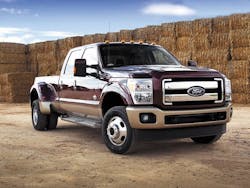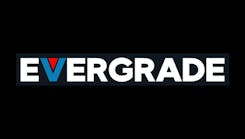If your customers who own diesel light trucks use their vehicles either for work or fun in dirty and muddy conditions, they are exposing their trucks to engine contamination issues. Dirt that gets past the air filter can pose a risk to the turbocharger. Although diesel components are beefier in construction than those in vehicles with gas engines, they are still susceptible to problems. Here are some solutions!
As you know, a diesel engine differs from other liquid fuel engines in one major respect: the fuel/air charge is ignited by cylinder pressure and resulting heat, instead of via an electrical ignition system (diesel-fueled engines don’t use spark plugs).
On its downstroke, a piston draws air into the cylinder. On the compression stroke, the fuel injection system (depending on how it’s timed) sprays fuel into the combustion area, and the resulting cylinder pressure (and residual heat from previous firings) combusts the fuel/air mix, etc.
Diesel heads generally don’t feature combustion chambers (flat decks with no chambers). Instead, the combustion chamber is afforded by the piston’s “bowl” cavity. Partly because of the serious cylinder pressures and forces exerted on the bottom end, diesel components (blocks, cranks, rods, pistons) are, for lack of a better term, heavy-duty and very beefy in construction. As compared to gas engines, just about everything on a diesel is bigger, heavier and more massive.
Rather than provide an overall discussion of diesels in general, in this article we’ll focus on one specific area, involving the Ford Powerstroke 6.4L turbo engine featured in 2008-2010 Ford light- and heavy-duty trucks. This engine features twin sequential turbos and a healthy 17.5:1 compression ratio, as well as a diesel particulate filter system (DPF).
Glow plug system
As but one example, here we’ll cite the 2008 Ford 6.4L diesel engine found in F-35, 450 and 550 vehicles.
Each cylinder features a glow plug that provides a temperature rise to facilitate fuel/air ignition at startup. This system features a glow plug control module (GPCM). Glow plug on-time is dependent on engine oil temperature and altitude. The GPCM does not operate if the oil temperature is above 131 degrees Fahrenheit.
In order to test glow plug operation, connect a scan tool and access/retrieve the key-off/engine-off (KOEO) and continuous DTCs. If GPCM DTCs are present, go to pinpoint test (refer to the manual).
Verify that B+ voltage is supplied to the GPCM. Access and monitor the glow plug lamp time (GPLTM) and electronic control transmission onboard diagnostic parameter identification (ECT PIDS) to verify sufficient glow plug on-time. Turn the ignition to the ON position and measure the glow plug voltage during the on-time, which may range between 1 to 120 seconds, again depending on oil temperature and altitude.
Check glow plug resistance by disconnecting the glow plug bus bar connector. Measure the resistance between the glow plug bus bar connector, component side and battery ground. Disconnect the GPCM. Measure the resistance between the GPCM connector, harness side and the glow plug bus bar connector, harness side. Glow plug to ground should be 0.1 to 2 ohms. Glow plug bus bar connector to GPCM connector should be less than 5 ohms. Check for poor connections or loose fitting pins. Note that incorrect measurements will result if all glow plug connectors are not disconnected.
The glow plug monitor self-test is a key-on/engine-running (KOER) test of the glow plug system. The self-test is carried out on-demand with the engine running and the A/C off. The PCM activates the GPCM which monitors the glow plugs. The throttle pedal may be used to increase engine speed to increase voltage if needed. Possible causes of concerns:
- GPCM power circuits
- Glow plugs
- Glow plug bus bar
- GPCM
- Circuitry
1 – GPCM
2 – Black connector
3 – Green connector
4 – Cylinder 5 glow plug
5 – Cylinder 7 glow plug
6 – Cylinder 1 glow plug
7 – Cylinder 3 glow plug
8 – Cylinder 6 glow plug
9 – Cylinder 8 glow plug
10 – Cylinder 2 glow plug
11 – Cylinder 4 glow plug
12 – VBAT (vehicle battery voltage)
13 – Glow plug enable (GPE)
14 – Diagnostic communication
15 – VPWR (vehicle power supply voltage)
Art courtesy of Motologic
6.4L Powerstroke fuel system
The 6.4L Ford Powerstroke diesel engine, like its earlier cousins, features a low pressure fuel system that delivers fuel from the tank to the high pressure pump. The high pressure pump increases fuel pressure for delivery to the fuel injectors. A fuel cooler system cools fuel that returns from the injectors and the high pressure pump.
In the low pressure system, fuel is pumped from the fuel tank to the primary fuel filter by the electric pump at about 5 psi to 10 psi during engine idle. Fuel is pumped to the secondary fuel filter which is located on the left front of the engine. The filtered fuel flows to the high pressure pump. A pressure regulator located in the secondary filter sends some of the fuel back to the tank.
As noted, after the secondary filter, fuel is sent to the high pressure fuel injection pump. The high pressure pump is gear-driven by a gear on the camshaft and is located at the rear of the engine, in the engine’s upper valley, requiring removal of the turbos and intake manifold. It’s important to note that while the inlet pressure to the high pressure pump may be as little as 3 psi to 6 psi, the high pressure pump is capable of increasing fuel pressure to in excess of 24,000 psi. Normal operating high pressure to drive the injectors is about 5,500 psi, with pressure increasing depending on load.
The high pressure pump delivers fuel to the fuel rails through two high pressure lines (one per bank). NEVER attempt to disconnect fuel lines with the system pressurized. According to published procedures, the system can be de-pressurized with the engine off and cooled to room temperature and then waiting at least five minutes.
The system pressure generated by the high pressure pump is constantly adjusted by the PCM. The injectors are operated in three stages: fill stage, main injection stage and end-of-main-injection stage.
The fill stage is designed to reduce combustion noise, mechanical load and exhaust emissions. The fuel enters the control piston chamber, spring side of the fuel injector valve and the high pressure chamber. A piezo actuator is not energized at this point. The control piston and the needle control spring downward force overcomes the upward force in the high pressure chamber. The nozzle is seated and no more fuel can enter the combustion chamber.
When the PCM commands the fuel injector on, during the main injection stage, the piezo actuator is energized and pushes the valve piston downward. This downward force pushes the injector valve and fuel return spring down, which opens a bore hole that connects the control piston chamber with the fuel return chamber. A small amount of fuel then flows from the control piston chamber to the fuel return chamber, reducing the pressure of the control piston. The pressure drop is enough for the upward force in the high pressure chamber to overcome the downward force of the control piston, allowing the nozzle needle to move up, allowing fuel to atomize and enter the combustion chamber.
At the end of the main injection stage, the small amount of fuel that flows from the control piston chamber to the fuel return chamber is routed through a drilled passage to drain holes. The drain holes are located on the sides of the injectors, below the O-ring. The fuel then returns to the fuel supply system through passages in the cylinder heads. When the desired injection timing is reached, the PCM de-energizes the piezo actuator which causes the valve piston to move upward, and the fuel injector valve return spring to push the injector valve up and seal the bored passage between the control valve chamber and the fuel return chamber, preventing any fuel to pass through. The pressure in the control valve chamber increases, causing the downward force of the control piston to overcome the upward force in the high pressure chamber, seating the nozzle needle and preventing more fuel from entering the combustion chamber.
A fuel cooling system maintains fuel and turbocharger actuator temperature. The fuel system temperature is monitored by a fuel rail temperature sensor (FRT), which is an input to the PCM. The PCM commands the fuel cooler pump on by grounding the pump when the fuel or turbo actuator temperature exceeds a calibrated threshold. Coolant in the system flows from the fuel-to-coolant heat exchanger to a fuel cooler reservoir, to the turbo actuator, to the fuel cooler air-to-coolant heat exchanger, to the fuel cooler pump and back to the fuel-to-coolant heat exchanger.
Power stroke 6.4L fuel injection system
- Accelerator pedal position sensor (APP)
- Powertrain control module (PCM)
- Electronic circuit
- High pressure fuel to the injectors
- Low pressure fuel to the cooler
- Variable turbocharger geometry position sensor
- Engine coolant temperature sensor (ECT)
- Fuel rail pressure sensor (FRP)
- Exhaust gas recirculation valve position sensor (EGR)
- Mass air flow sensor (MAF) and intake air temperature sensor (IAT)
- Intake air temperature 2 sensor
- Exhaust pressure sensor (EP)
- Exhaust gas recirculation temperature sensor (EGRT)
- Exhaust gas temperature sensor (EGT)
- Engine oil temperature sensor (EOT)
- Manifold absolute pressure sensor (MAP)
- Crankshaft position sensor (CKP)
- Camshaft position sensor (CMP)
- Fuel rail temperature sensor (FRT)
- Fuel cooling system
- Low pressure fuel pump
- Secondary fuel filter housing
- High pressure fuel injection pump
- Fuel injectors (8)
Art courtesy of Motologic
High pressure fuel injection pump operation
After the low pressure fuel is filtered by the secondary fuel filter, it enters the high pressure fuel injection pump. Fuel pressure is then increased in steps by the transfer pump. The transfer pump is integral to the high pressure pump and is driven by the pump’s main shaft. A portion of the fuel leaving the transfer pump flows to the lubrication valve which allows the fuel to lubricate the mechanical components of the high pressure pump.
Fuel that is not used for pump lubrication is directed to the fuel volume control valve. This valve regulates how much fuel enters the inlet one-way check valve and the three main pump pistons. The three main pump pistons are actuated by the main shaft’s offset journal. The shaft offset uses a free-spinning hub to make contact with the three main pump pistons. The pistons start their compression stroke when actuated by the offset journal and are returned to their rest position by spring pressure. Fuel is drawn into the main cylinder while the pistons return to rest position.
The outlet check valve ball remains closed while fuel is drawn in by suction. Once the pistons start a compression stroke, the inlet one-way check valve closes using spring and fuel pressure and the outlet check valve opens due to the fuel pressure increase. After the high pressure fuel leaves the three main pump pistons, pressure is controlled by the fuel pressure control valve. A portion of the fuel leaves the pump and flows to the fuel cooler, with the rest of the fuel delivered to the high pressure fuel rails and injectors.
High pressure fuel injection pump
- Fuel flow from secondary fuel filter to high pressure pump
- Transfer pump
- Inlet one-way check valve
- High pressure pump piston
- Outlet check valve
- Fuel volume control valve
- Lubrication valve
- Gap filter
- Low pressure fuel flow to fuel cooler
- Fuel pressure control valve
- High pressure fuel flow to fuel rail
Art courtesy of Motologic
High pressure pump problem
The Ford Powerstroke 6.4L high pressure fuel pumps are problematic and more prone to damage if the fuel filter is not changed per Ford’s maintenance schedule. A DTC P0088 (fuel rail/system pressure too high) indicates that the fuel pressure control valve in the pump is sticking. The pressure control valve cannot be repaired or replaced on its own, as it’s integral to the pump assembly.
The “killer code” P0088 requires a high pressure pump replacement. Depending on the source, replacement pumps run in the area of $1,000 to $1,600. Ford techs are seeing high pressure pump issues due to metal debris contamination. One likely cause is the failure to perform proper maintenance. The low pressure fuel pump/water separator/filter unit is mounted near the tank, on the frame.
A water drain valve petcock is located on this unit, which allows draining water from the fuel. Ford recommends draining water every 30 days. However, due to the unit’s location and the owners’ negligence in not routinely opening this drain, water builds up in the fuel, contaminating and diluting lubrication for the high pressure pump. In the end, the metal debris contaminates the entire fuel system, requiring replacement of the entire fuel system, at a parts and labor cost of about $6,000. The need to perform routine maintenance of the fuel system cannot be overemphasized.
Powerstroke 6.4L pump harness glitch
2008 Ford F-350 6.4L diesels are prone to a VPWR (vehicle power supply voltage) fuse blow-out. This is a known issue, where the 20-amp fuse fails due to wire chafing in the harness to the high pressure fuel pump circuit, resulting in a short.
Oil dilution concern
Oil dilution caused by fuel entering the crankcase is a major concern on any engine. This can occur on a low scale on any engine, which is another reason to pay attention to engine oil change intervals. If oil dilution is excessive, you run the very real risk of premature bearing/frictional wear, elevated oil temperature, and in severe cases, this can result in a hydro-lock.
According to reports from the field, the 6.4L Powerstroke diesel engine seems to be prone to oil dilution, with fuel slipping past the piston rings and accumulating in the oil sump. This appears to me more prevalent on DPF (diesel particulate filter) equipped engines that experience more regeneration cycles.
While Ford recommends an engine oil change every 10,000 miles, some diesel technicians recommend a shorter oil change interval of about 5,000 miles. The engine oil level should be checked weekly. If a rise in level is noticed, this is a sure sign that excessive diesel fuel is entering the crankcase.
Fuel injector cleaning/rebuilding
Powerstroke injectors are precision-machined assemblies that are pricey to replace, to the tune of about $300 each. Cleaning and rebuilding is a viable option, at a fraction of that price. Shops that perform this service commonly use an ultrasonic cleaning tank to remove all contaminants from injector bodies and components, with rebuilt injectors tested and verified on a flow bench.
Check the air intake
The majority of diesel engines are turbocharged. Turbochargers must be protected against excessive heat, which is one reason the oil changes are so important. The heat generated in the turbo is high and engine oil injected to the turbo bearings is vital. The heat tends to break down the oil and if not changed with proper frequency the oil can cook and coke, reducing lubrication.
Another common area to check during any service is the air filter, filter housing and turbo intake. Many light-duty diesel powered trucks are used for commercial applications, many in dirty/dusty environments. In addition, a small percentage of diesel owner “enthusiasts” tend to operate off-road in dusty or muddy conditions.
To avoid dirt/grit contaminants from entering the turbo, check air inlets to make sure that the filter and filter housing are kept clean. ■



